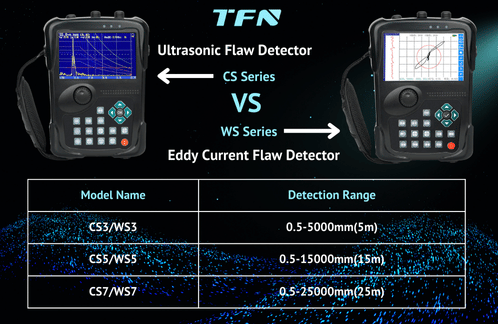The difference between Ultrasonic Flaw Detector and Eddy Current Flaw Detector
In the field of non-destructive testing, ultrasonic flaw detector and eddy current flaw detector are two commonly used technical equipment, each of which has unique principles and a wide range of application scenarios. This article will discuss the differences between these two flaw detectors in detail from three aspects: principle, use and classification.
1. Different Principles
Ultrasonic flaw detector: Uses the propagation characteristics of ultrasonic waves in materials to detect defects inside materials. When the ultrasonic beam enters the metal material from the probe, it will be reflected when encountering defects (such as cracks, pores, inclusions, etc.) or the bottom surface of the part, forming a reflected wave. After these reflected waves are received by the probe, they form a pulse waveform on the fluorescent screen. The inspector determines the location and size of the defect based on these waveforms. The working principle of the ultrasonic flaw detector is mainly based on the penetration method, pulse reflection method and serial method, etc., and the integrity and performance of the material are evaluated by measuring the propagation speed, reflection time and waveform characteristics of ultrasonic waves.
Eddy current flaw detector: Based on the eddy current detection principle, eddy current is generated in the conductive component through the excitation coil, and the change in eddy current is measured with the help of the detection coil, so as to obtain relevant information about the component defects. Eddy current detection is an electromagnetic induction phenomenon. When alternating current passes through a conductor, an alternating magnetic field is generated inside and around the conductor, and then eddy current is generated inside the conductor. When there are defects on the surface or near the surface of the conductor, the intensity and distribution of the eddy current will change. This change can be detected by the detection coil, and the existence of the defect can be judged accordingly.
2. Different Uses
Ultrasonic flaw detector: Its wide applicability is highly favored. It can be used in laboratory environments as well as in field engineering sites. It can quickly, conveniently, non-destructively and accurately detect, locate, evaluate and diagnose internal defects of metal and non-metal materials. Ultrasonic flaw detectors play an important role in many fields such as scientific research, electric power, petrochemicals, metallurgy, casting, automobiles, machinery, military industry, steel structures, boilers, pipelines, pressure vessels, aerospace, and railway transportation. Its detection range is wide, including pores, sand holes, inclusions, folds, cracks, incomplete fusion and incomplete penetration of welds in metal materials.
Eddy current flaw detector: It is mainly suitable for surface or near-surface defect detection of conductive materials. Due to its fast detection speed, high sensitivity, and no need for direct contact with the object to be measured, it is widely used in military industry, aviation, railways, industrial and mining enterprises and other fields. Eddy current flaw detectors are particularly suitable for detecting surface cracks, dark seams, slag inclusions and open cracks in metal pipes, rods, wires, silk, profiles and other materials. However, eddy current flaw detectors are inconvenient for testing components with complex shapes and are not suitable for testing non-conductive materials.
3. Different Classifications
Ultrasonic flaw detectors: According to different functions and application scenarios, they can be divided into many types. For example, digital ultrasonic flaw detectors usually have functions such as automatic calibration and free switching of scales, can display quantitative values in real time, and have large-capacity, high-performance lithium batteries, which are convenient for on-site operation. In addition, according to different image processing methods, ultrasonic flaw detectors can also be divided into A-type display, M-type display, B-type display and other types, each of which has its specific application scenarios and advantages.
Eddy current flaw detectors: Although there are also many models and specifications, their classification is mainly based on detection principles and structural characteristics. Eddy current flaw detectors are generally composed of oscillators, probe coils, signal detection devices, measurement comparison circuits, signal processing alarm displays and power supplies. These components work together to detect surface or near-surface defects of conductive materials.
Therefore, there are significant differences between ultrasonic flaw detectors and eddy current flaw detectors in terms of principles, uses and classifications. The choice of which flaw detector depends on the specific detection needs and material properties. In practical applications, inspectors should choose appropriate flaw detectors according to specific circumstances to ensure the accuracy and reliability of the test results.

If you are interested in TFN flaw detector, please contact TFN sales team:
Email: info@tfngj.com
WhatsApp: +86-18765219251
Facebook: https://www.facebook.com/tfnfate/
